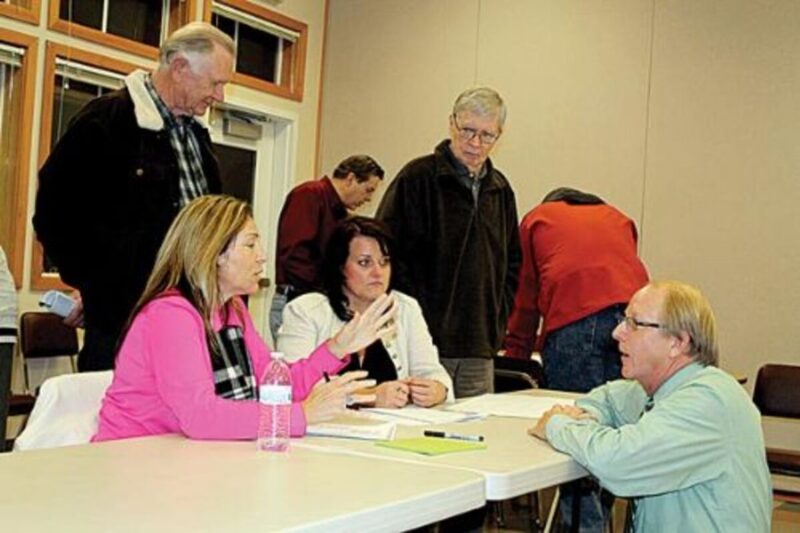Sean C. Morgan
Members of the Sweet Home community have added numerous new objectives to the proposed Strategic Plan, and at a meeting on Nov. 20, they suggested even more.
More than 30 attended the Nov. 20 meeting.
The Strategic Plan is a community document meant to serve as a guide, City Manager Craig Martin said. It’s not regulatory.
“It’s a living document that, as you move forward, you revisit and review it regularly,” Martin said.
Community members attending the meeting offered some suggestions for the parks system, and education drew a lot of ideas, said Julie Fisher, city planning assistant.
Suggestions in education included creating partnerships, developing college connections and creating a passion for lifelong learning. Other ideas included creating community memories among youngsters; developing open spaces, sports, dog trails, horse trails; maintaining a small-town lifestyle; reducing child abuse; developing recreational businesses around water sports, backpacking, fishing and brewing; creating cultural activities; maintaining Sweet Home’s volunteer spirit and replenishing the number of volunteers; and improving the transportation system.
It may be difficult to figure out specific objectives from the ideas, Fisher said, but the plan steering committee will meet and try to work them into the plan.
After working out a new draft of the Strategic Plan, the committee will host another community meeting in January to present the draft, Fisher said. At some point following that, the plan will go to the City Council for adoption.
After all of this feedback, there may be additional meetings and activity following the January meeting but before the council considers the plan, Fisher said.
Fisher said people have approached her since the meeting to ask about being on a committee to check on the progress of objectives and goals identified in the plan.
The community’s first Strategic Plan was created in 1989. The Oregon Economic Development Department facilitated the process, and one of the outcomes of that process was the creation of the Sweet Home Economic Development Group.
The plan was updated in 1993, 1997 and 2001. The City Council set a goal to update the plan again this year.
The most recent Strategic Plan update began in the spring when the city received an Oregon Watershed Enhancement Board grant for the preparation of a master plan for Hobart Natural Area, located at the south end of 35th Avenue. The city asked Chris Maser to conduct a public process to engage the community in creating a new vision for the Strategic Plan, with a focus on Hobart and other city parks.
The process began in April with a series of community workshops. Information was distributed to stakeholders to gain input on the community values among Sweet Home citizens.
Participants reviewed the community values and went to work creating a vision statement: “Sweet Home is a community where we live in harmony with the surrounding environment, supporting a clean, safe and economically viable small-town lifestyle for the benefit of present and future generations.”
The group created five goals designed to achieve the vision:
n Sweet Home is a community where well-being is based on a culture of social inclusivity.
n Sweet Home provides the skills and experiences for children to have a viable future in our town economically and socially so they will stay or return because of the childhood memories that they want to share with their children.
n Sweet Home protects and cares for its open space and natural environment as the foundation of its sustainable small-town atmosphere and livability.
n Sweet Home is a community that supports sustainable businesses that provide diverse employment for residents of all skill levels.
n Sweet Home makes decisions that maintain a population and urban growth boundary compatible with a sustainably built environment that protects the beauty and function of the natural environment.
To achieve each goal, the committee has identified numerous projects called objectives. Objectives are projects in which completion of the task is measurable.
Among the objectives identified going into the Nov. 20 meeting were measuring Sweet Home’s homeless population, finding ways to reach out to the community’s commuter population, finding ways to engage the commuter population in the community, clarifying the ethnic diversity of Sweet Home compared to the state, conducting a survey identifying obstacles for ethnic diversity in Sweet Home and creating a list of facilities that support the physical well-being of persons of all ages under the first goal.
Under the second goal, objectives include providing programs that teach youths the knowledge and experience they need to become successful citizens, involving students in the Tree Commission and encouraging enhanced programs in math, science and technology.
The third goal contains eight objectives relating to parks, including the adoption of a master plan, identifying open space used as “water catchment” within the urban growth boundary, providing opportunities to access and picnic at Hobart Park, completing the Hobart stewardship plan, ensuring support for the urban forest program to maintain Tree City status, completing tree planting on Main Street based on the Tree Planting Master Plan, identifying an area for a pine grove within the city and providing opportunities for children and the community to be acquainted with and reconnect to the natural environment.
Under the fourth goal, objectives include developing questions to ask existing and potential businesses to determine how the business relates to the vision, developing a profile that identifies the desirable attributes of sustainable businesses for Sweet Home and conducting a tourism marketing survey.
Under the fifth goal, objectives include defining the characteristics of cultural capacity, determining the population level that sustains cultural capacity and reviewing and revising land use regulations and other city standards to protect the cultural capacity and open space.
The fifth set of objectives are designed to answer how many people the community can have and still maintain the small-town quality of life, Maser said.
Anyone interested in more information or getting involved in the planning process may contact Fisher at (541) 367-8113.





